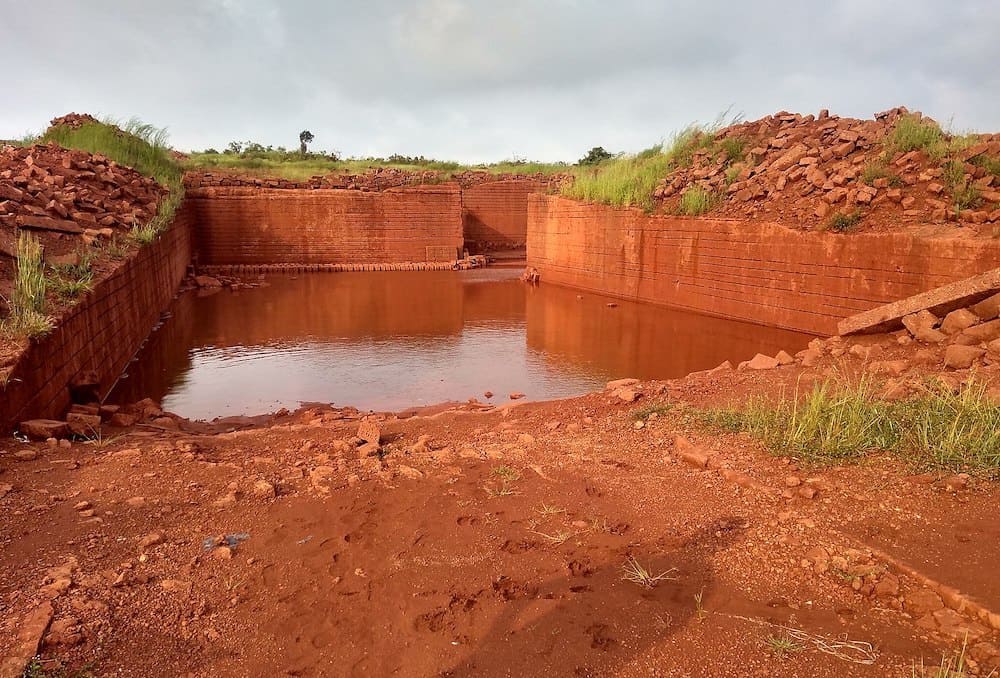
[Image above] A dug-out laterite rock quarry in India. Laterite is often considered a worthless material that is used only for a few primary purposes such as bricks and road building materials, but researchers in Sri Lanka see it as a potential alternative to bauxite for sourcing aluminum. Credit: Hiway.sharma, Wikimedia (CC BY-SA 4.0)
As the world invests more in green energy technologies, much focus is given to the materials that make the technologies possible, such as cobalt in electric vehicle batteries and perovskites in solar cells. However, it is important to consider the materials that compose the supporting infrastructure for the technologies as well.
“Aluminium is used in most clean-air power technologies but particularly solar, where it accounts for 85% of most photovoltaic (PV) components in the form of the frames that hold the PV panels together,” a Reuters article explains.
The heavy reliance on aluminum is not surprising, considering aluminum is the most widely used nonferrous metal in the world. However, the ubiquity of this metal in our everyday lives can sometimes lead us to overlook potential threats to its supply chain.
The primary source of aluminum is the sedimentary rock bauxite. The aluminum market does not normally pay much heed to disruptions at the bauxite end of the supply chain, but in 2020 the European Union added bauxite to its critical raw materials list in recognition of the increased strain placed on global bauxite resources due to aluminum demand.
At the beginning of this month, concerns over bauxite supply rose in response to a coup in the West African country of Guinea, one of the world’s top bauxite producers. Though production losses have historically tended to be quickly compensated, and the industry expects this time to be no different, “the market is becoming more sensitive to supply disruption at any stage of the bauxite-alumina-metal processing chain,” a Reuters article explains.
For these reasons, identifying alternative and sustainable sources of aluminum is an important goal for the aluminum industry. In a recent open-access study, researchers at the University of Peradeniya in Sri Lanka explore the potential of laterite as an alternative aluminum source.
Laterite is both a soil and a rock type rich in iron and aluminum. It is a product of intense weathering of silicate rocks under strongly oxidizing and leaching conditions, and it is abundant in tropical regions of the world including India, Australia, Africa, Indonesia, and Sri Lanka.
Laterite is often considered a worthless material that is used only for a few primary purposes such as bricks and road building materials. But its relative richness in iron and aluminum “makes this a material with high industrial potential as the cost for the raw materials is low compared to the other high-grade ores,” the researchers write.
They begin their exploration of laterite’s potential by explaining why the Bayer process, the main method for extracting aluminum oxide from bauxite, would not work for laterite.
“[The Bayer process] includes the reaction of the (bauxitic) raw materials with NaOH and re-precipitate as Al2O3 using a seed crystallization method. However, it is a known fact that the Bayer process is not effective in low-grade bauxites, especially when the relative iron content is > 5% … Thus, this process doesn’t look compatible with laterite where the iron content is much higher than typical low-grade bauxite,” they write.
Instead, the researchers explored using an acid leaching extraction method, which they optimized using data from previous studies on the kinetics of acid leaching of laterites.
They determined that the most suitable conditions for acid leaching extraction involve an acid in the concentration of 5 M and a temperature above 90°C. If extracting iron is the goal, then the acid HCl should be used. If extracting aluminum is the goal, then the acid H2SO4 should be used.
After determining the optimum extraction conditions, the researchers took the aluminum oxide extract and explored turning it into value-added micromaterials and nanomaterials. Using a sol–gel process, they successfully synthesized alumina nanospheres that can be used in light-emitting diodes, semiconductors, and next-generation applications such as matrix-reinforced ceramics, among others.
“Hence this study is a successful attempt in utilizing laterites as an alternative for bauxite,” they conclude.
The open-access paper, published in Cleaner Materials, is “Laterite and its potential as an alternative-bauxite” (DOI: 10.1016/j.clema.2021.100016).
Author
Lisa McDonald
CTT Categories
- Basic Science
- Manufacturing
- Market Insights


